Page 1968 of 5267
INSPECTION
Camshaft
CAMSHAFT DIMENSIONS
CAMSHAFT DIMENSIONS
Journal diameter (No.1 and No.7)
Min. 54.028 mm. (2.127 in.)
Max. 54.048 mm. (2.128 in.)
Journal diameter (No.2 through No.6)
Min.53.962 mm. (2.1245 in.)
Max.54.013 mm. (2.1265 in.)
Diameter of peak of lobe
Intake
Min.47.175 mm (1.857 in.)
Max47.855 mm.
Exhaust
Min. 45.632 mm. (1.797 in.)
Max. 46.312 mm. (1.823 in.)
1. Inspect the valve lobes (1) and bearing journals (2)
for cracks, pitting, scoring, or generally excessive
wear. Replace any camshaft that exceeds the
allowable limits.
2. Measure the bearing journals and lobes.
CAUTION: If Camshaft lobes are worn, requiring
camshaft replacement, it is necessary to replace
the tappets also. (Refer to 9 - ENGINE/ENGINE
BLOCK/SOLID LIFTERS - REMOVAL).
Page 1969 of 5267
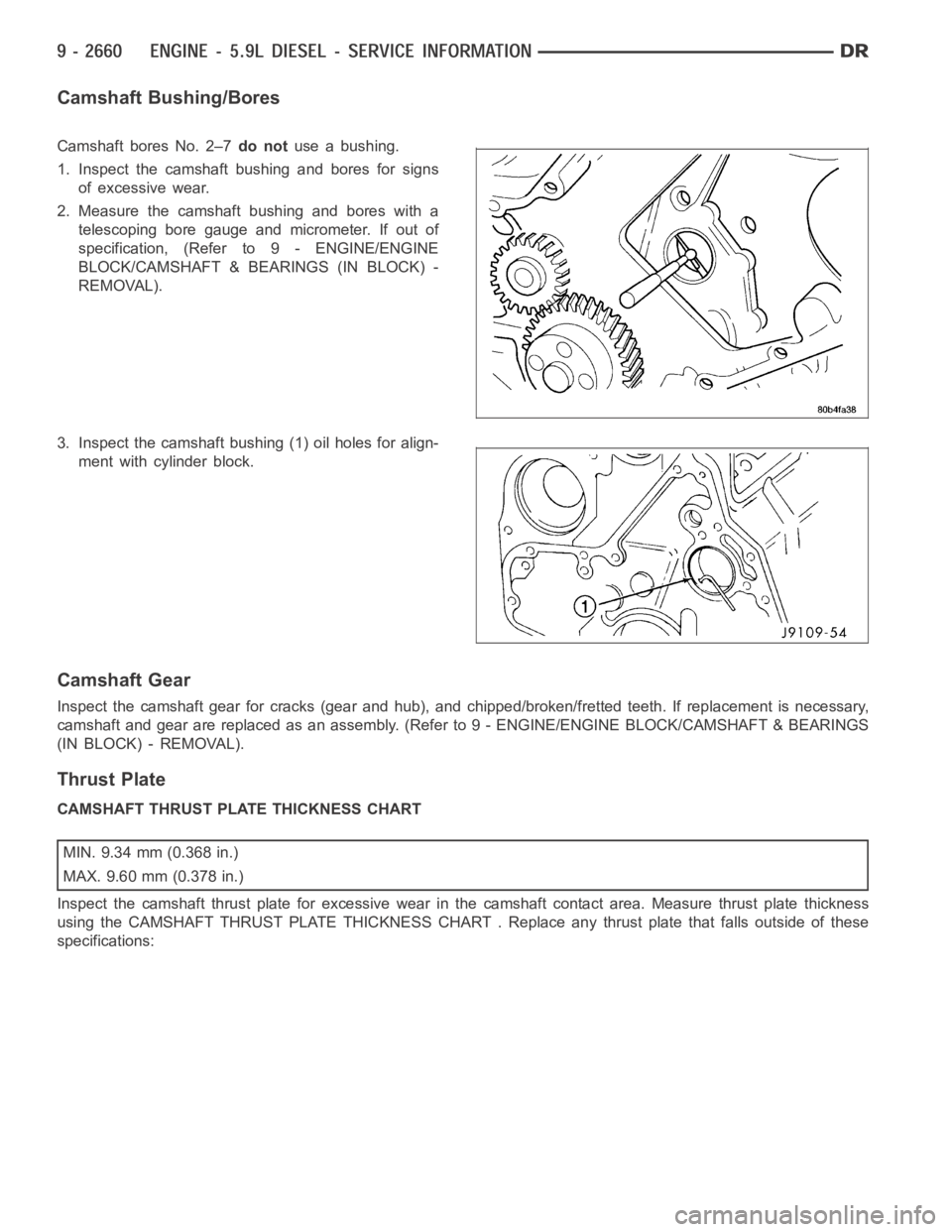
Camshaft Bushing/Bores
Camshaft bores No. 2–7do notuse a bushing.
1. Inspect the camshaft bushing and bores for signs
of excessive wear.
2. Measure the camshaft bushing and bores with a
telescoping bore gauge and micrometer. If out of
specification, (Refer to 9 - ENGINE/ENGINE
BLOCK/CAMSHAFT & BEARINGS (IN BLOCK) -
REMOVAL).
3. Inspect the camshaft bushing (1) oil holes for align-
ment with cylinder block.
Camshaft Gear
Inspect the camshaft gear for cracks (gear and hub), and chipped/broken/fretted teeth. If replacement is necessary,
camshaft and gear are replaced as an assembly. (Refer to 9 - ENGINE/ENGINE BLOCK/CAMSHAFT & BEARINGS
(IN BLOCK) - REMOVAL).
Thrust Plate
CAMSHAFT THRUST PLATE THICKNESS CHART
MIN. 9.34 mm (0.368 in.)
MAX. 9.60 mm (0.378 in.)
Inspect the camshaft thrust plate for excessive wear in the camshaft contact area. Measure thrust plate thickness
using the CAMSHAFT THRUST PLATE THICKNESS CHART . Replace any thrust platethat falls outside of these
specifications:
Page 1970 of 5267
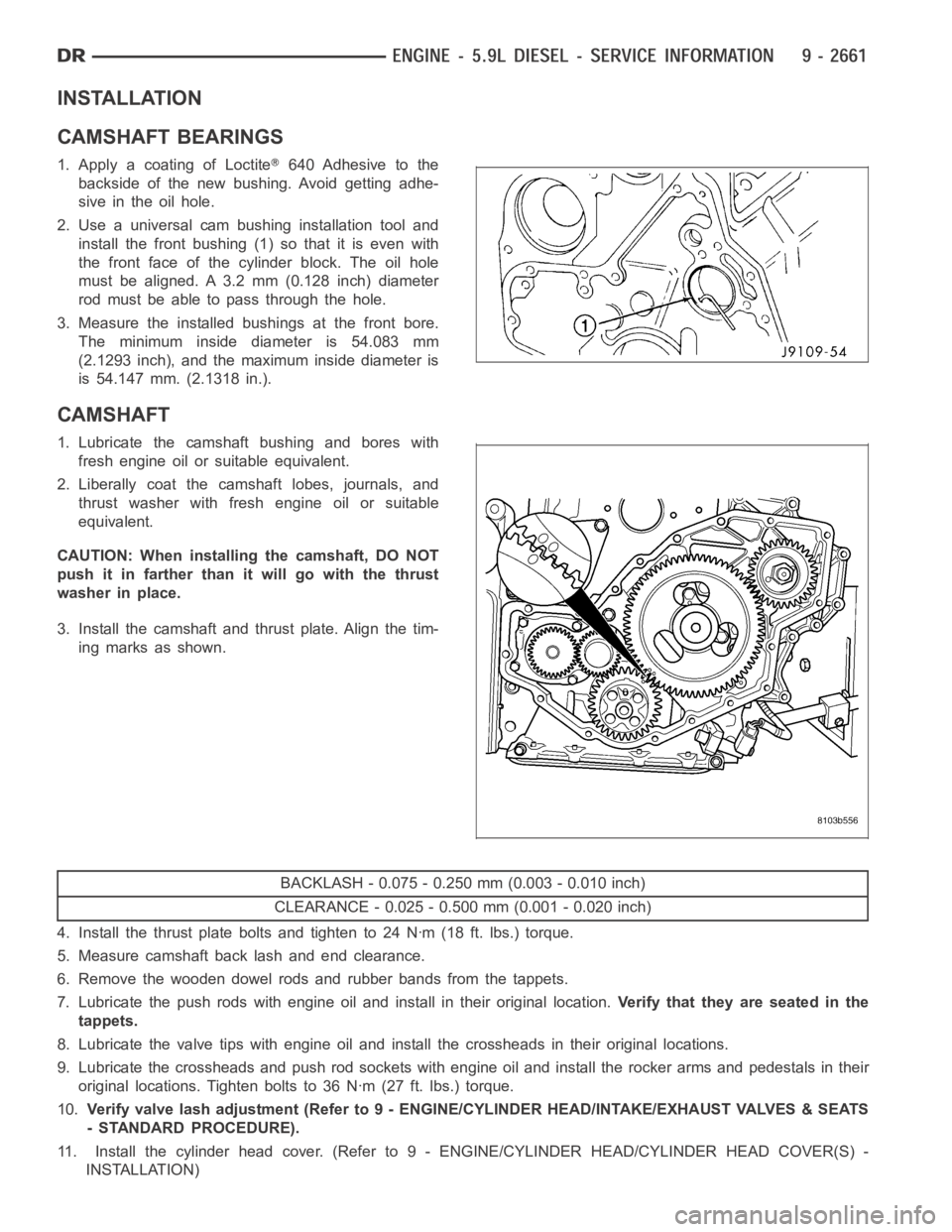
INSTALLATION
CAMSHAFT BEARINGS
1. Apply a coating of Loctite640 Adhesive to the
backside of the new bushing. Avoid getting adhe-
sive in the oil hole.
2. Use a universal cam bushing installation tool and
install the front bushing (1) so that it is even with
the front face of the cylinder block. The oil hole
must be aligned. A 3.2 mm (0.128 inch) diameter
rod must be able to pass through the hole.
3. Measure the installed bushings at the front bore.
The minimum inside diameter is 54.083 mm
(2.1293 inch), and the maximum inside diameter is
is 54.147 mm. (2.1318 in.).
CAMSHAFT
1. Lubricate the camshaft bushing and bores with
fresh engine oil or suitable equivalent.
2. Liberally coat the camshaft lobes, journals, and
thrust washer with fresh engine oil or suitable
equivalent.
CAUTION: When installing the camshaft, DO NOT
push it in farther than it will go with the thrust
washer in place.
3. Install the camshaft and thrust plate. Align the tim-
ing marks as shown.
BACKLASH - 0.075 - 0.250 mm (0.003 - 0.010 inch)
CLEARANCE - 0.025 - 0.500 mm (0.001 - 0.020 inch)
4. Install the thrust plate bolts and tighten to 24 Nꞏm (18 ft. lbs.) torque.
5. Measure camshaft back lash and end clearance.
6. Remove the wooden dowel rods and rubber bands from the tappets.
7. Lubricate the push rods with engine oil and install in their original location.Verify that they are seated in the
tappets.
8. Lubricate the valve tips with engine oil and install the crossheads in their original locations.
9. Lubricate the crossheads and push rod sockets with engine oil and install the rocker arms and pedestals in their
original locations. Tighten bolts to 36 Nꞏm (27 ft. lbs.) torque.
10.Verify valve lash adjustment (Refer to 9 - ENGINE/CYLINDER HEAD/INTAKE/EXHAUST VALVES & SEATS
- STANDARD PROCEDURE).
11. Install the cylinder head cover. (Refer to 9 - ENGINE/CYLINDER HEAD/CYLINDER HEAD COVER(S) -
INSTALLATION)
Page 1971 of 5267
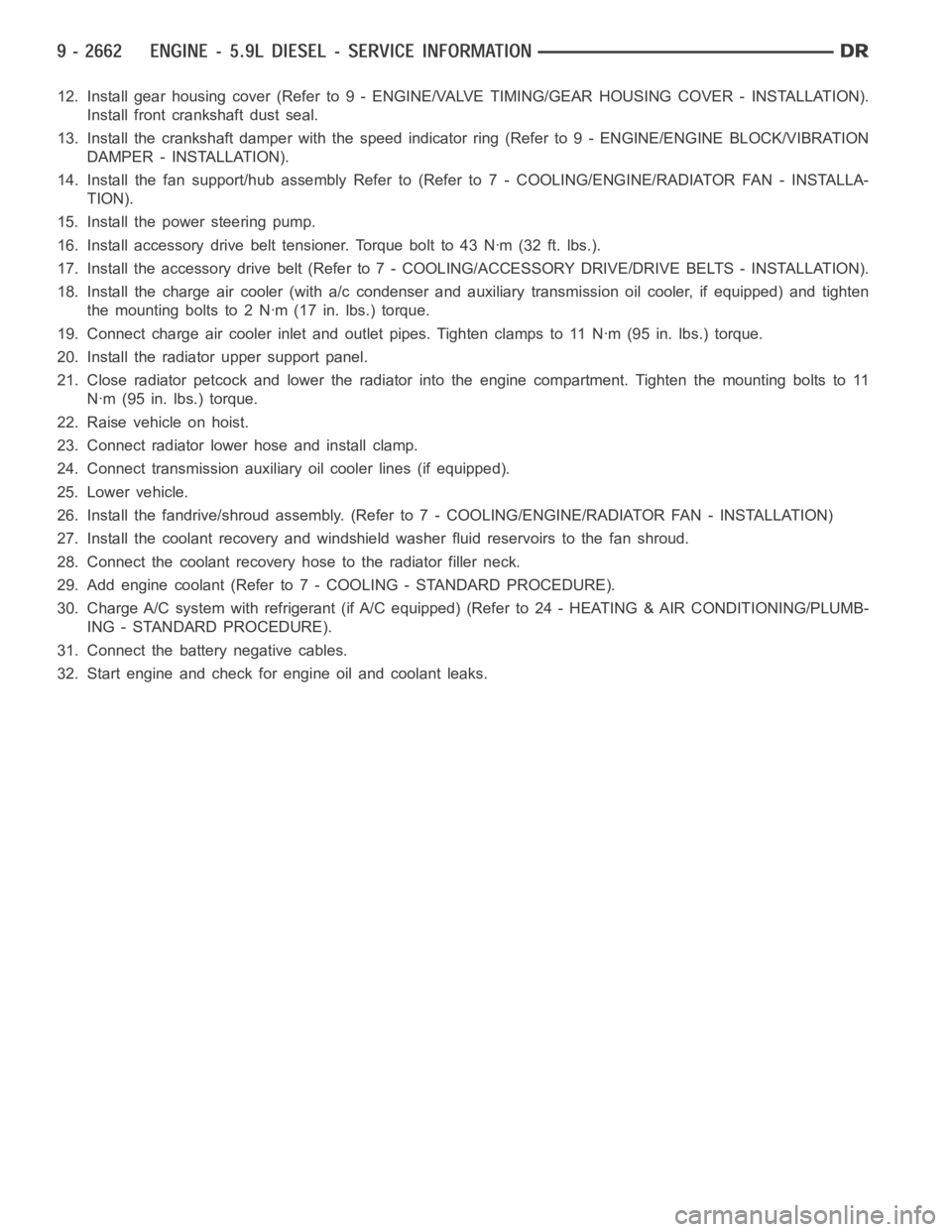
12. Install gear housing cover (Refer to 9 - ENGINE/VALVE TIMING/GEAR HOUSING COVER - INSTALLATION).
Install front crankshaft dust seal.
13. Install the crankshaft damper with the speed indicator ring (Refer to 9- ENGINE/ENGINE BLOCK/VIBRATION
DAMPER - INSTALLATION).
14. Install the fan support/hub assembly Refer to (Refer to 7 - COOLING/ENGINE/RADIATOR FAN - INSTALLA-
TION).
15. Install the power steering pump.
16. Install accessory drive belt tensioner. Torque bolt to 43 Nꞏm (32 ft. lbs.).
17. Install the accessory drive belt (Refer to 7 - COOLING/ACCESSORY DRIVE/DRIVE BELTS - INSTALLATION).
18. Install the charge air cooler (with a/c condenser and auxiliary transmission oil cooler, if equipped) and tighten
the mounting bolts to 2 Nꞏm (17 in. lbs.) torque.
19. Connect charge air cooler inlet and outlet pipes. Tighten clamps to 11 Nꞏm (95 in. lbs.) torque.
20. Install the radiator upper support panel.
21. Close radiator petcock and lower the radiator into the engine compartment. Tighten the mounting bolts to 11
Nꞏm (95 in. lbs.) torque.
22. Raise vehicle on hoist.
23. Connect radiator lower hose and install clamp.
24. Connect transmission auxiliary oil cooler lines (if equipped).
25. Lower vehicle.
26. Install the fandrive/shroud assembly. (Refer to 7 - COOLING/ENGINE/RADIATOR FAN - INSTALLATION)
27. Install the coolant recovery and windshield washer fluid reservoirs to the fan shroud.
28. Connect the coolant recovery hose to the radiator filler neck.
29. Add engine coolant (Refer to 7 - COOLING - STANDARD PROCEDURE).
30. Charge A/C system with refrigerant (if A/C equipped) (Refer to 24 - HEATING & AIR CONDITIONING/PLUMB-
ING - STANDARD PROCEDURE).
31. Connect the battery negative cables.
32. Start engine and check for engine oil and coolant leaks.
Page 1973 of 5267
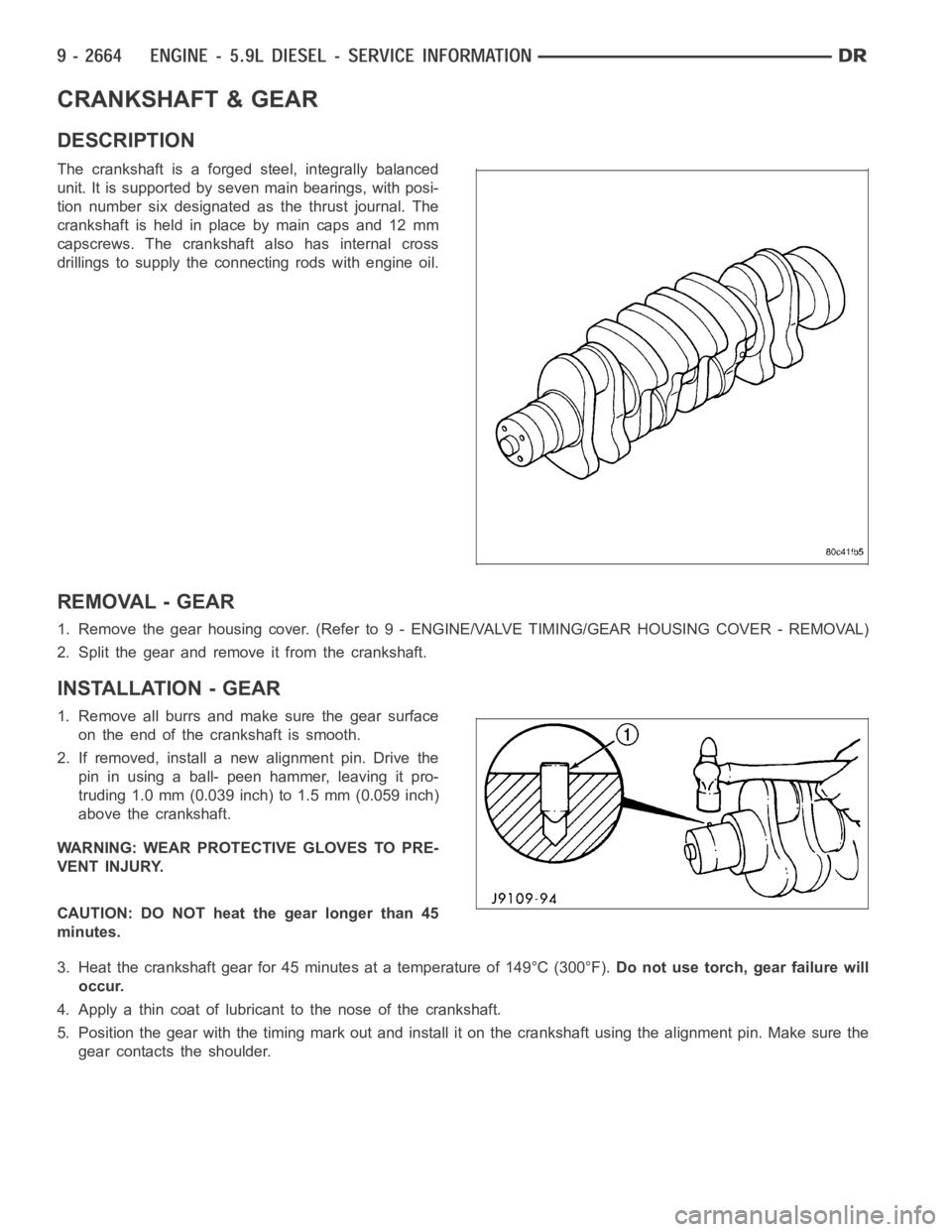
CRANKSHAFT & GEAR
DESCRIPTION
The crankshaft is a forged steel, integrally balanced
unit. It is supported by seven main bearings, with posi-
tion number six designated as the thrust journal. The
crankshaft is held in place by main caps and 12 mm
capscrews. The crankshaft also has internal cross
drillings to supply the connecting rods with engine oil.
REMOVAL - GEAR
1. Remove the gear housing cover. (Refer to 9 - ENGINE/VALVE TIMING/GEAR HOUSING COVER - REMOVAL)
2. Split the gear and remove it from the crankshaft.
INSTALLATION - GEAR
1. Remove all burrs and make sure the gear surface
on the end of the crankshaft is smooth.
2. If removed, install a new alignment pin. Drive the
pin in using a ball- peen hammer, leaving it pro-
truding 1.0 mm (0.039 inch) to 1.5 mm (0.059 inch)
above the crankshaft.
WARNING: WEAR PROTECTIVE GLOVES TO PRE-
VENT INJURY.
CAUTION: DO NOT heat the gear longer than 45
minutes.
3. Heat the crankshaft gear for 45 minutes at a temperature of 149°C (300°F).Do not use torch, gear failure will
occur.
4. Apply a thin coat of lubricant to the nose of the crankshaft.
5. Position the gear with the timing mark out and install it on the crankshaft using the alignment pin. Make sure the
gear contacts the shoulder.
Page 1976 of 5267
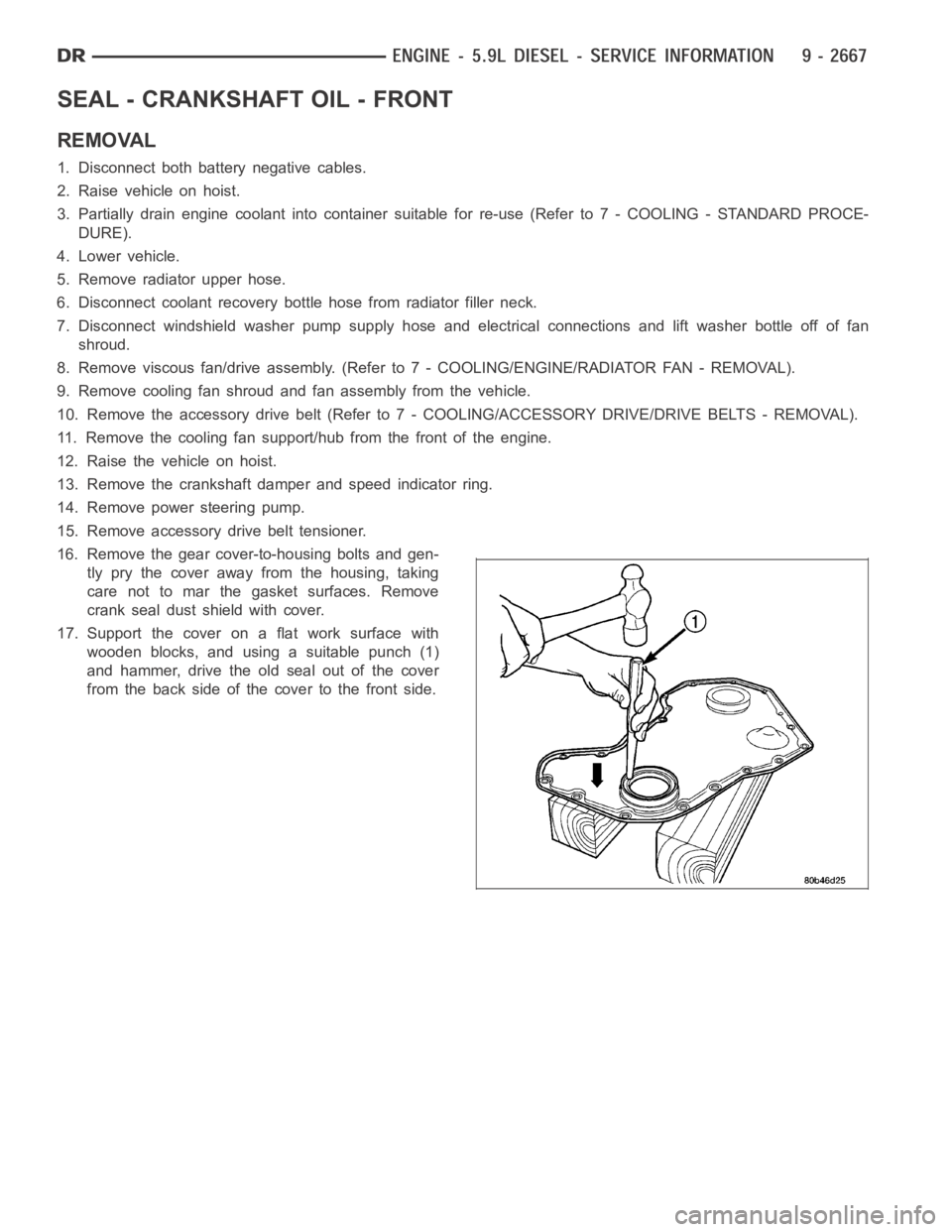
SEAL - CRANKSHAFT OIL - FRONT
REMOVAL
1. Disconnect both battery negative cables.
2. Raise vehicle on hoist.
3. Partially drain engine coolant into container suitable for re-use (Refer to 7 - COOLING - STANDARD PROCE-
DURE).
4. Lower vehicle.
5. Remove radiator upper hose.
6. Disconnect coolant recovery bottle hose from radiator filler neck.
7. Disconnect windshield washer pump supply hose and electrical connections and lift washer bottle off of fan
shroud.
8. Remove viscous fan/drive assembly. (Refer to 7 - COOLING/ENGINE/RADIATOR FAN - REMOVAL).
9. Remove cooling fan shroud and fan assembly from the vehicle.
10. Remove the accessory drive belt (Refer to 7 - COOLING/ACCESSORY DRIVE/DRIVE BELTS - REMOVAL).
11. Remove the cooling fan support/hub from the front of the engine.
12. Raisethevehicleonhoist.
13. Remove the crankshaft damper and speed indicator ring.
14. Remove power steering pump.
15. Remove accessory drive belt tensioner.
16. Remove the gear cover-to-housing bolts and gen-
tly pry the cover away from the housing, taking
care not to mar the gasket surfaces. Remove
crank seal dust shield with cover.
17. Support the cover on a flat work surface with
wooden blocks, and using a suitable punch (1)
and hammer, drive the old seal out of the cover
from the back side of the cover to the front side.
Page 1977 of 5267

INSTALLATION
CAUTION: The seal lip and the sealing surface on
thecrankshaftmustbefreeofalloilresidue,to
prevent leaks. The crankshaft and seal surface
must be completely dry when the seal is installed.
1. Clean cover and housing gasket mating surfaces.
Use a suitable scraper and be careful not to dam-
age the gear housing surface. Remove any old
sealer from the oil seal bore. Thoroughly clean the
front seal area of the crankshaft. Do not sand this
surface. The seal lip and the sealing surface on the
crankshaft must be free from all oil residue to pre-
vent seal leaks.
2. Inspect the gear housing and cover for cracks and
replace if necessary. Carefully straighten any bends
or imperfections in the gear cover with a ball-peen
hammer on a flat surface. Inspect the crankshaft
front journal for any grooves or nicks that would
affect the integrity of the new seal.
3. Apply a bead of Mopar
Stud & Bearing Mount to
the outside diameter of the seal. Do not lubricate the inside diameter of thenewseal.
4. With the cover supported by wood blocks, install the seal into the rear ofthe cover using crankshaft seal installer
Special Tool 8281 and driver handle C-4171. Strike the driver handle untilthe installation tool bottoms out on the
inside of the cover.
CAUTION: Do not distort or damage seal.
5. Install the plastic seal pilot (provided with seal kit)
into the crankshaft seal.
6. Apply a bead of Mopar
Silicone Rubber Adhesive
Sealant or equivalent to the gear housing cover
sealing surface.
7. Install the cover to the gear housing, aligning the
seal pilot with the nose of the crankshaft.
NOTE: Failure to follow the cover installation pro-
cedure can result in misalignment of the crank-
shaft seal to the crankshaft, causing an oil leak.
8. Install the cover bolts and hand snug 2 capscrews
at the 3 o’clock and 9 o’clock position, to keep the
cover from moving when the first capscrew is
torqued. Torque to 24 Nꞏm (18 ft. lbs.) torque. Remove pilot tool.
9. Install dust shield over nose of crankshaft.
10. Install the crankshaft damper and speed indicator ring. Torque the bolts to 40 Nꞏm (30 ft. lbs.). Then rotate an
additional 60°. Use the engine barring tool to keep the engine from rotating during tightening operation.
11. Install the fan support/hub assembly and torque bolts to 32 Nꞏm (24 ft. lbs.).
12. Install power steering pump.
13. Install accessory drive belt tensioner. Torque bolt to 43 Nꞏm (32 ft.lbs.).
14. Install cooling fan (Refer to 7 - COOLING/ENGINE/RADIATOR FAN - INSTALLATION).
15. Install the accessory drive belt (Refer to 7 - COOLING/ACCESSORY DRIVE/DRIVE BELTS - INSTALLATION).
16. Refill cooling system (Refer to 7 - COOLING - STANDARD PROCEDURE).
17. Connect battery negative cables.
Page 1978 of 5267
18. Start engine and check for oil leaks.